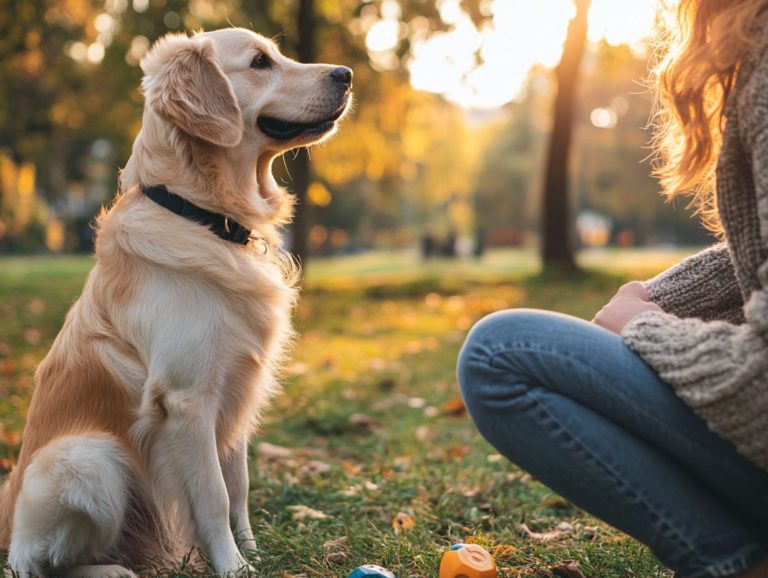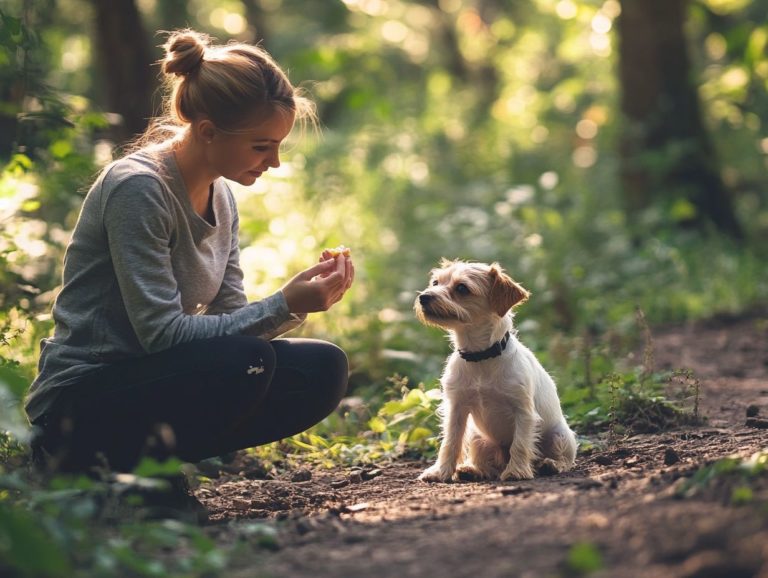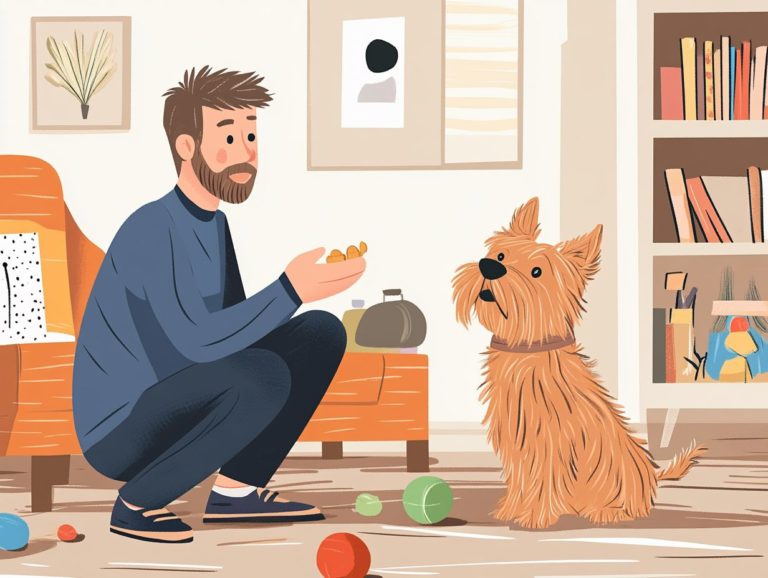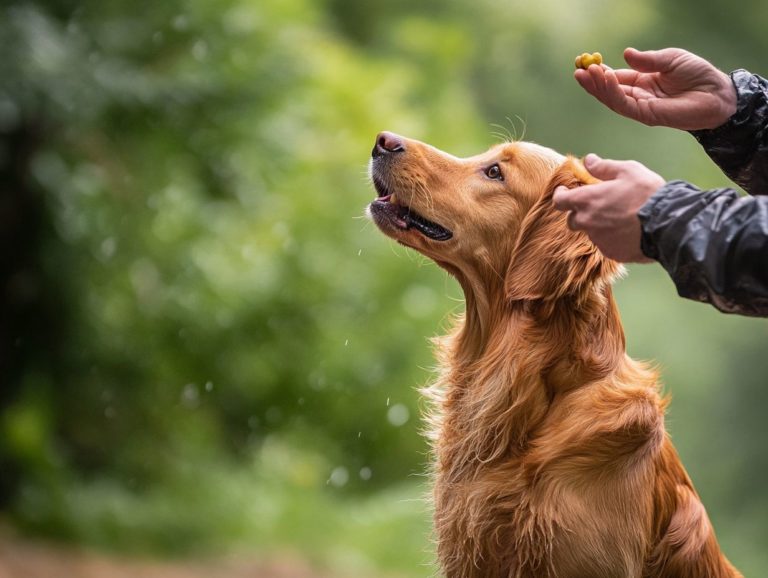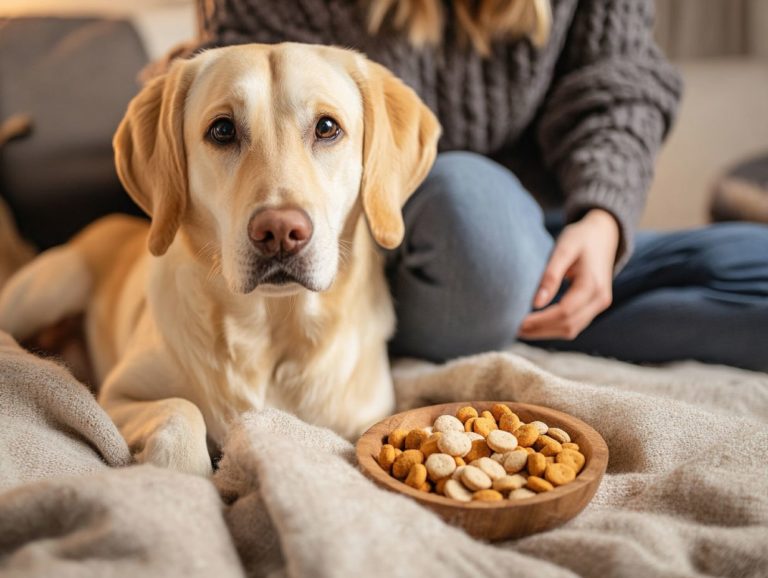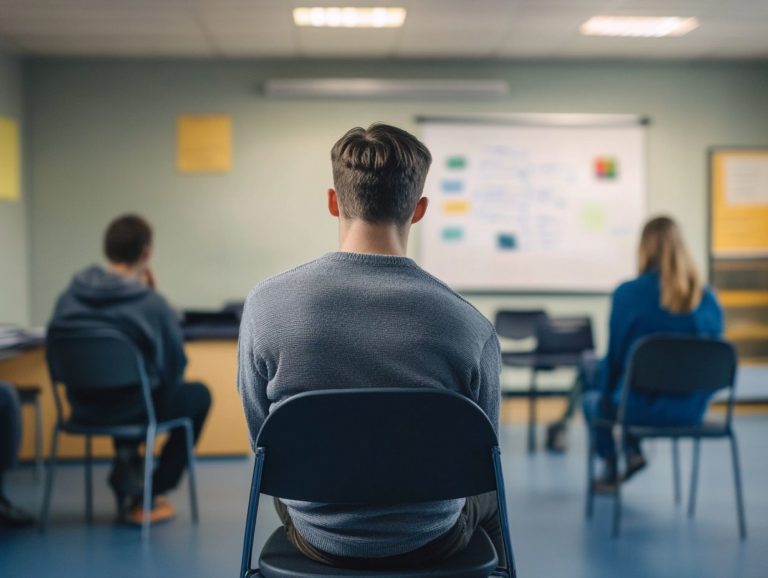Effective Techniques for Training Anxious Puppies
Puppy anxiety is a common hurdle that many new pet owners encounter, often resulting in frustration for both the puppy and the family. Recognizing the signs of dog anxiety, such as a tail between legs or excessive barking, is crucial for effective management.
Understanding the causes and triggers of this anxiety, including separation anxiety and fear triggers, is your first step toward helping your furry friend feel secure. This guide will help you transform your anxious pup into a confident buddy!
You’ll also learn when to seek help from a trainer or behaviorist and why consistency and patience are crucial in your training approach. With the right strategies in place, you can help your puppy build confidence and resilience.
Contents
- Key Takeaways:
- Understanding Puppy Anxiety
- Creating a Safe and Calm Environment
- Positive Reinforcement Training
- Exposure Training
- Seeking Professional Help
- Consistency and Patience
- Frequently Asked Questions
- What Are Effective Techniques for Training Anxious Puppies?
- How Can Positive Reinforcement Help Train Anxious Puppies?
- What Is Getting Used to Things Slowly and How Can It Be Used for Training Anxious Puppies?
- Can Counterconditioning Be Used to Train Anxious Puppies?
- Are There Any Specific Tips for Training Anxious Puppies?
- Is It Possible for Anxious Puppies to Overcome Their Anxiety Through Training?
Key Takeaways:
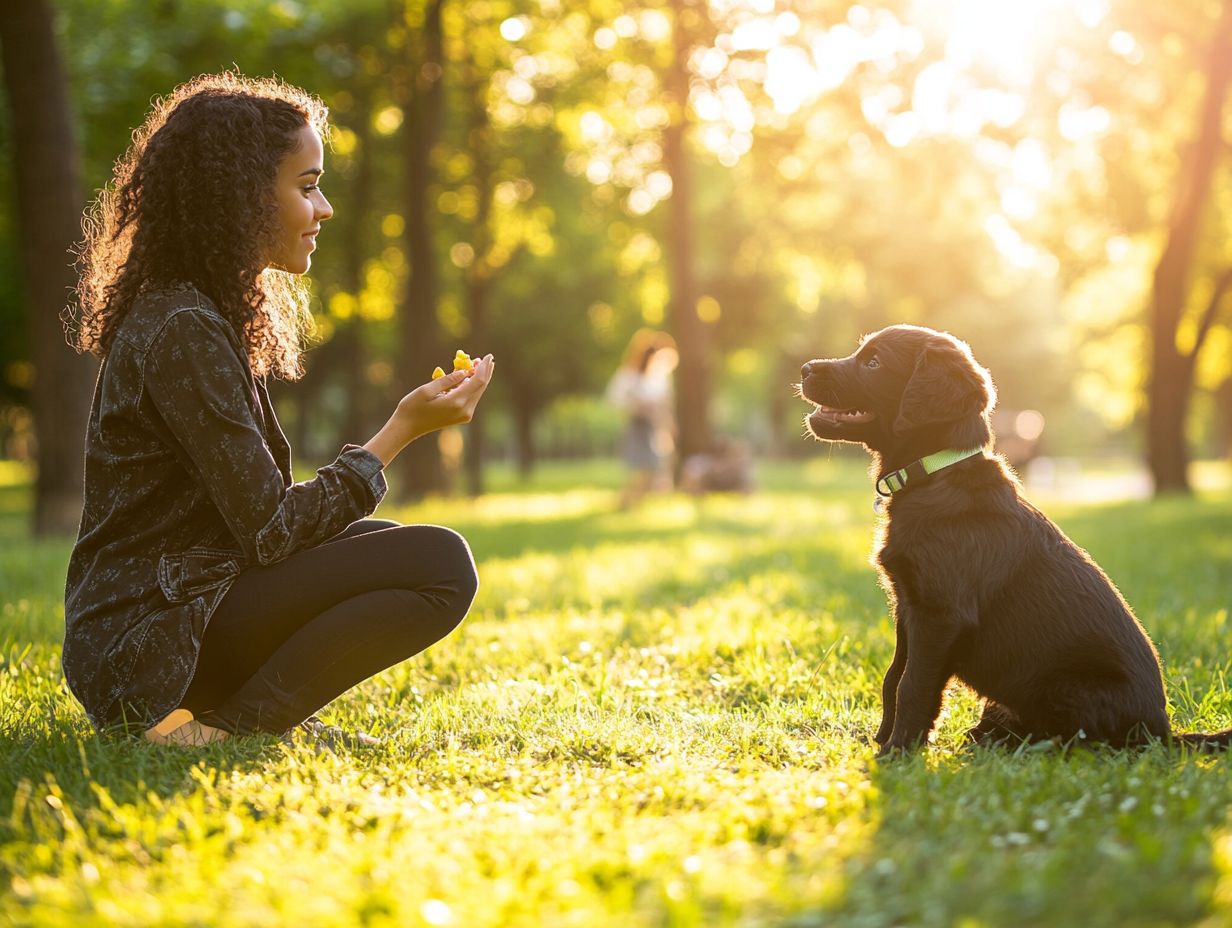
- Puppy anxiety can be caused by various factors such as genetics, past experiences, and lack of socialization. Addressing these triggers is essential in the training process.
- To create a safe and calm environment for anxious puppies, it is important to have a designated space, such as a cozy dog crate, provide comfort items, and limit exposure to triggers.
- Positive reinforcement, such as treats and praise, is an effective way to train anxious puppies while helping them build their confidence.
Understanding Puppy Anxiety
Understanding puppy anxiety is essential for anyone looking to raise a confident, well-adjusted dog. Anxiety in dogs can arise from various sources, such as separation issues, fear triggers, or insufficient socialization.
By tuning into your puppy’s emotional state, you can effectively address their needs and help them build confidence. Resources from the AKC, the GoodDog! Helpline, as well as insights from veterinarians and animal behaviorists provide valuable guidance on managing dog anxiety.
Observing your puppy’s body language for signs of stress and establishing a consistent routine can significantly enhance their sense of companionship and emotional well-being.
Causes and Common Triggers
The causes of puppy anxiety can vary significantly, and recognizing these common triggers, such as loud noises or unfamiliar people, is crucial for effective training. Factors like loud noises, changes in routine, or even the presence of unfamiliar people or animals can prompt a fear response in puppies, leading to symptoms like excessive barking or hiding.
Addressing these triggers through positive reinforcement, gradual exposure to scary things, and effective training techniques is essential for helping your puppy feel secure in its environment.
Identifying specific triggers starts with observing your puppy’s behavior and noting when anxiety arises. For example, sudden loud noises like thunderstorms or fireworks can cause distress, while moments of separation from you might induce panic.
To manage these anxiety responses, create a safe space, such as a cozy dog bed or dog crate, where your puppy can retreat during stressful situations. By incorporating effective techniques for training anxious senior pets, such as gradual exposure and rewarding calm behavior, you can help build your puppy’s confidence.
By fostering a reassuring environment, you ll not only strengthen the bond with your puppy but also make training and socialization a smoother process in the long run, creating a happy dog.
Creating a Safe and Calm Environment
Creating a safe and serene environment is essential for managing dog anxiety and nurturing emotional well-being. By offering a comfortable space, such as a dog crate or a cozy dog bed, you can help your puppy feel secure and at home.
Integrating mental stimulation and relaxation techniques, such as calming music, while also adhering to a reliable routine, enables effective anxiety management. This approach fosters a happy dog who feels completely at ease in their surroundings.
Don t wait to help your puppy feel safe!
Setting up the Right Space
Setting up the perfect space for your puppy can profoundly affect their emotional well-being and overall behavior. By creating a designated area that feels both comforting and secure, you can significantly influence your companion’s development. This allows for better socialization.
A dog crate serves not only as an enclosed sanctuary for your pup to retreat to when feeling overwhelmed, but it also fosters independence. They learn that it’s a safe place to relax, which can aid in their obedience training.
Soft bedding is essential for cushioning their joints while offering a familiar scent that can be incredibly soothing. Interactive chew toys help reduce anxiety. They also promote healthy chewing habits and give your puppy a positive outlet for their energy.
When combined, these elements cultivate a calmer disposition. This enables your puppy to thrive in a nurturing environment, reinforcing their emotional well-being.
Positive Reinforcement Training
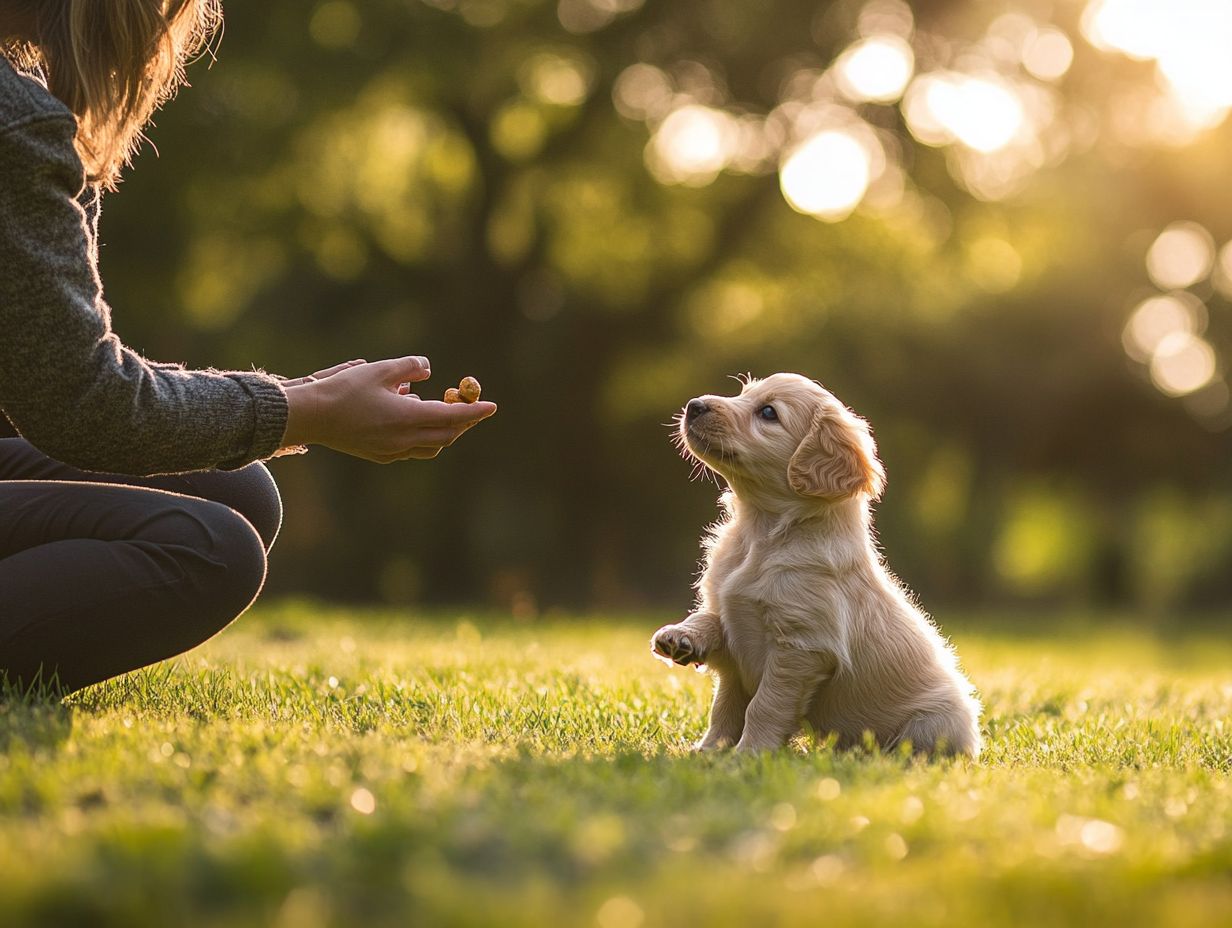
Positive reinforcement training is an invaluable tool for addressing dog anxiety and fostering confident behaviors in puppies. This method revolves around rewarding desired actions with treats, praise, and affection, encouraging puppies to repeat those behaviors. For specific strategies, check out these tips for training anxious pets at home.
By adopting effective training techniques, including obedience training and emphasizing positive reinforcement, you can create a nurturing learning environment. Incorporating clicker training for anxious dogs enhances emotional well-being and alleviates anxiety in your furry companions.
Using Rewards and Praise
Using rewards and praise effectively can elevate the training experience for both you and your puppy. This turns it into something enjoyable and fulfilling, which is crucial for building confidence. When you consistently deliver treat rewards, you help your puppy form positive associations with the behaviors you want to encourage. This motivates them to engage and learn while reducing the likelihood of fear responses.
This method enhances training while strengthening the bond between you and your furry companion. It leads to a happy dog who feels secure and confident in their abilities, essential for emotional stability.
Incorporating a variety of treat rewards, like high-value snacks or beloved toys, keeps training sessions fresh and exciting. Pairing these rewards with enthusiastic praise creates a nurturing environment where even anxious dogs can thrive. When they begin to associate training with fun and positive reinforcement, it significantly reduces their stress and builds emotional resilience, essential for overcoming anxiety.
Over time, this approach boosts learning outcomes and fosters a sense of well-being. It encourages a more relaxed demeanor in previously anxious pups, helping them become confident.
Exposure Training
Exposure training is crucial for assisting your puppy in overcoming fear responses to specific triggers. Implementing socialization techniques for anxious pets ultimately leads to effective anxiety management through gradual exposure.
This process introduces the anxiety-inducing stimulus in a controlled setting, enabling your puppy to build a more positive association over time, which is key in behavioral training.
By employing various behavioral tools and dedicated training techniques specifically for anxious breeds, while dedicating the necessary time to address these fears, you can enable your puppy to confront challenges with confidence.
Gradual Exposure to Triggers
Gradual exposure to triggers is a key strategy in helping your dog feel less scared. By introducing your puppy to triggers at manageable levels and maintaining a calm environment, you can assist your pet in acclimating without feeling overwhelmed. This promotes a sense of security.
When you pair these exposures with positive reinforcement, you ensure that your puppy forms positive associations instead of negative experiences. This reduces the likelihood of panic attacks.
For instance, if your puppy is anxious about loud noises, you might begin by playing recordings of soft sounds at a low volume. To help ease their anxiety, consider using techniques outlined in how to handle anxious pets during training sessions. Reward your puppy with treats or praise whenever they remain calm, reinforcing their courage. As your puppy becomes more comfortable, gradually increase the volume. Always take breaks if anxiety starts to creep in to maintain a positive experience.
Another approach is to introduce unfamiliar people or animals from a safe distance. You can gradually decrease that distance as your puppy gains confidence, helping them overcome fear triggers. Throughout this journey, remain calm and reassuring. A stable environment fosters trust, making training more effective and enjoyable for both of you.
Seeking Professional Help
Seeking professional assistance is often an essential step for dog owners facing serious anxiety problems in their puppies. Engaging with professional trainers, veterinarians, and animal behaviorists can offer you tailored guidance through training classes that tackle specific behavioral concerns, including the top training techniques to reduce pet anxiety.
In some cases, they may recommend anxiety medication along with training classes to help manage your dog’s anxiety effectively.
When to Consult a Trainer or Veterinarian
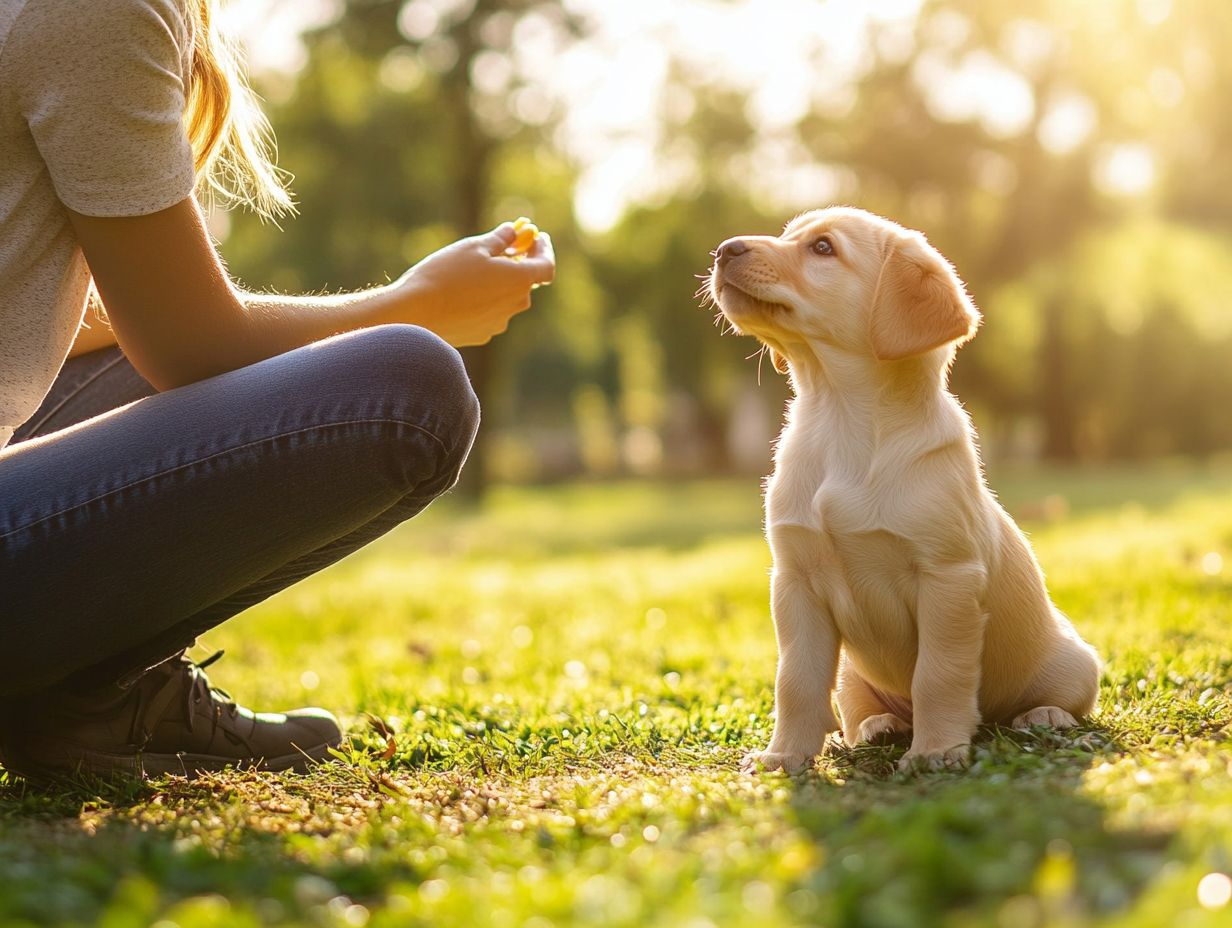
Knowing when to consult a trainer or veterinarian is crucial for managing your puppy’s anxiety. If you notice persistent panic attacks, extreme emotional discomfort, or behavioral issues that won’t budge despite your at-home efforts, it may be time to seek professional help from a qualified trainer or animal behaviorist.
It s important to recognize subtle indicators, such as changes in canine body language. Have you noticed aggressive behavior, excessive barking, or destructive habits without clear triggers? These could signal deeper anxiety issues that warrant professional intervention.
If your puppy shows changes in appetite, experiences sleep disturbances, or starts to withdraw from social interactions, seeking help becomes even more vital. A trained professional can offer tailored techniques and support, ensuring your puppy feels safer and develops healthier coping mechanisms to thrive in their environment.
Consistency and Patience
Consistency and patience are essential in training puppies struggling with anxiety. By establishing a reliable routine, you provide your puppy with a sense of security and clear expectations. Implementing training techniques to manage aggression in anxious pets can further enhance their stability, which is crucial for their emotional well-being.
Patience allows them to learn and adjust at their own pace, which is vital for their development. By embracing these principles, you can create a nurturing environment that enhances training and helps your puppy build confidence over time.
Keys to Successful Training
The keys to successful training lie in implementing strategies that foster effective learning, emotional well-being, and a strong bond between you and your dog.
By prioritizing clear and consistent communication, you help your canine companion fully grasp your expectations, minimizing confusion and anxiety. Techniques like clicker training offer immediate feedback, reinforcing their learning and helping them feel safe.
Celebrate small victories along the way! This not only strengthens your relationship but also creates a more positive training atmosphere. By emphasizing these approaches, you enhance the overall training experience, leading to a well-adjusted dog who feels valued and understood.
Frequently Asked Questions
What Are Effective Techniques for Training Anxious Puppies?
Some effective techniques include positive reinforcement, getting used to things slowly, and counterconditioning.
How Can Positive Reinforcement Help Train Anxious Puppies?
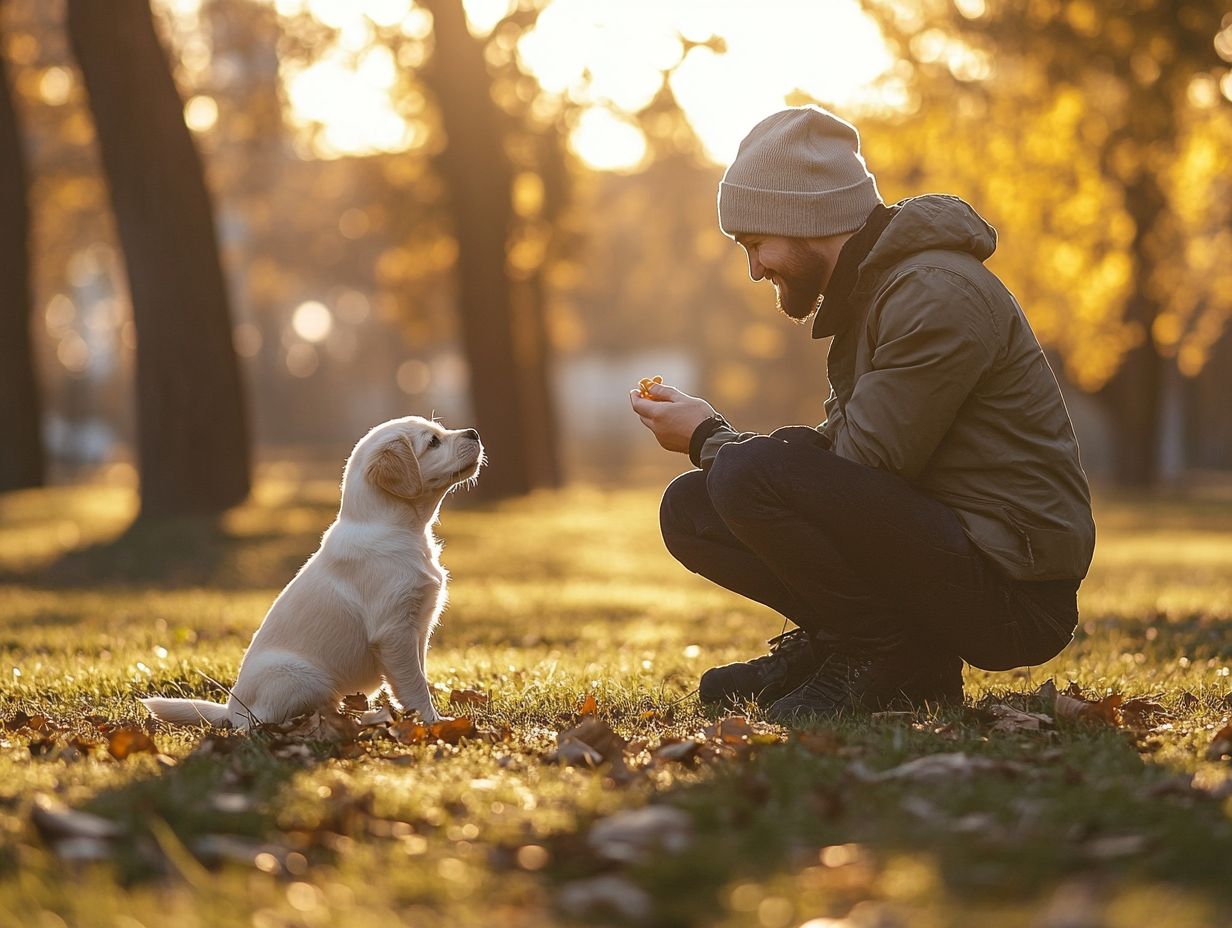
Positive reinforcement involves rewarding desired behaviors. This can help anxious puppies feel more confident and motivated to learn.
What Is Getting Used to Things Slowly and How Can It Be Used for Training Anxious Puppies?
Getting used to things slowly involves gradually exposing puppies to what makes them anxious in a controlled and positive manner. This helps them become more comfortable over time.
Can Counterconditioning Be Used to Train Anxious Puppies?
Yes! Counterconditioning pairs what makes the puppy anxious with something positive, like treats or playtime. This helps create a positive association and reduces anxiety.
Are There Any Specific Tips for Training Anxious Puppies?
- Keep training sessions short and positive.
- Avoid punishment.
- Provide a safe and calm environment for the puppy to learn in.
Is It Possible for Anxious Puppies to Overcome Their Anxiety Through Training?
Yes! With patience, consistency, and the right techniques to calm anxious pets before training, anxious puppies can learn to overcome their anxiety and become well-adjusted, confident dogs.
Start training your anxious puppy today! Early action can lead to better results.

